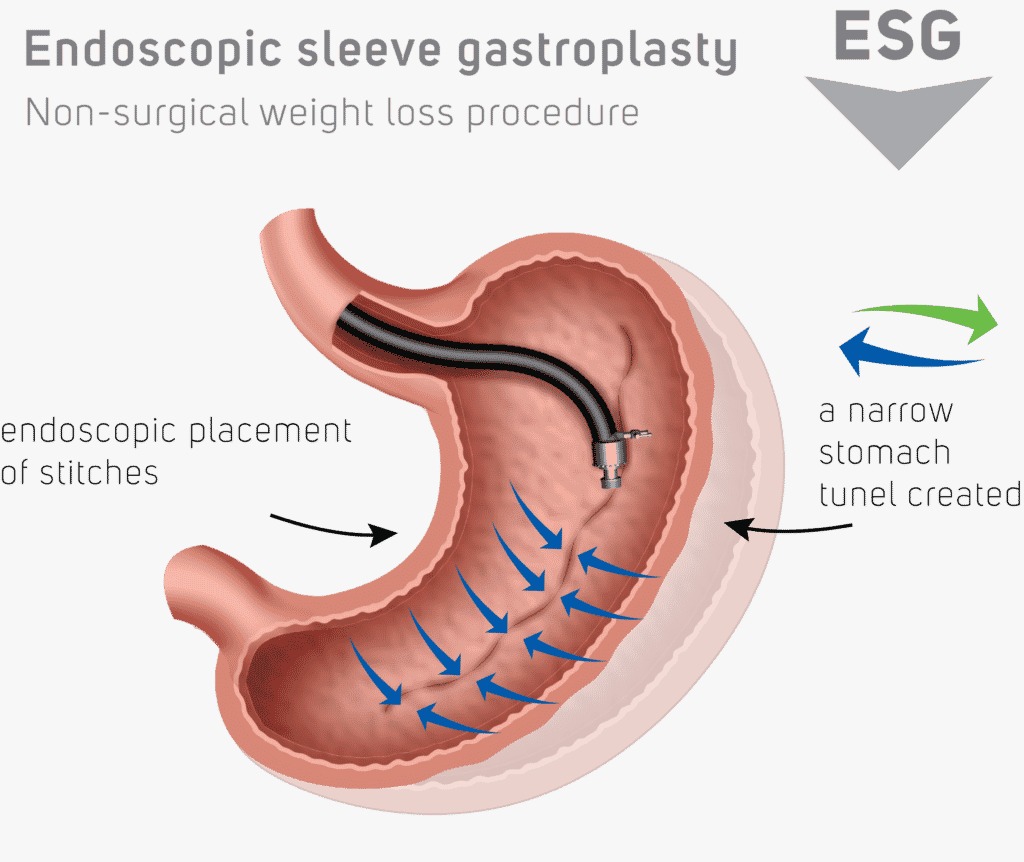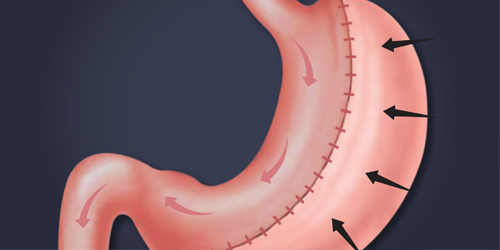
The Sleeve Gastrectomy procedure involves removing a large portion of the stomach to form a tube. The amount of food and the speed of absorption are drastically and permanently reduced. Weight loss is long-lasting and significant, requiring the patient to change their eating behavior.
With a gastric sleeve, patients can generally lose between 15 and 40 kilograms, depending on their body size, sometimes even more. By physically reducing the size of the stomach, the sleeve dramatically alters the body's response to food consumption. Patients no longer feel hungry, and weight loss occurs over the months and years following the procedure. The risk of weight regain is extremely low in the long term.
Sleeve Gastrectomy details
Sleeve Gastrectomy
Prices
About
What is Sleeve Gastrectomy?
Also known as "calibrated vertical gastroplasty with gastric resection" or "longitudinal gastrectomy," sleeve gastrectomy is a digestive surgical procedure performed on obese patients. This operation involves removing a portion of the stomach to shape it into a tube. First performed in 2001, sleeve gastrectomy enables patients to lose a considerable amount of weight by inducing a rapid feeling of fullness, resulting from the reduction of ghrelin, the appetite hormone.

Technique of the Sleeve
The sleeve, the most frequently practiced technique, involves removing approximately 2/3 of the stomach. This restrictive technique entails removing the portion containing cells that secrete the appetite-stimulating hormone, ghrelin. The stomach is reduced to a vertical tube, and food passes quickly into the intestine. Weight loss is approximately 25 to 35 kilograms.
This technique does not disrupt the digestion of food because it is initially slowed as it passes through the tube, then rapidly evacuated into the intestine. The sleeve acts through two complementary mechanisms: restriction associated with a decrease in the level of ghrelin, the hunger hormone, thereby causing a decreased interest in food.

Surgical Approach of the Sleeve
The intervention is performed laparoscopically, very rarely by laparotomy. Incisions (usually 3 to 5) are made in the abdomen, and trocars are placed. A tube, called a bougie, is introduced through the mouth into the stomach. It serves as a calibration tool for the new stomach. Using an automatic clamp, the stomach is cut and sutured simultaneously with a triple row of staples. The resected portion of the stomach is then removed from the abdomen.
The incisions are sutured with absorbable thread.
Diagnostic for Sleeve Gastrectomy
The operative indication is considered for those with a BMI greater than 30 in most countries.
In France, sleeve gastrectomy is only offered for those with a BMI greater than 40 (morbid obesity) or starting from a BMI greater than 35 if complications are confirmed.

What Type of Anesthesia for Sleeve Gastrectomy?
The sleeve operation is performed under general anesthesia and typically lasts about 2 hours.
How Long Does It Take to Perform a Sleeve Gastrectomy?
The duration of hospitalization varies from 2 to 4 days depending on the type of procedure and the general condition of the individual. It may be extended if complications arise after the surgery. A minimum of 2 weeks off work should be planned after leaving the hospital. Like any abdominal surgery, postoperative recovery can be painful.

Traveling for a sleeve only takes 5 to 7 days
Traveling Abroad for a Sleeve Gastrectomy?
The necessary travel time is generally 5 to 7 days in total. Once the risk of leaks is ruled out and verified, the patient can return to their home country.
What Weight Loss Can You Expect?
The sleeve gastrectomy can lead to significant weight loss. However, the exact amount of weight lost depends on several factors, including the size of the removed part of the stomach, the patient's post-operative dietary habits, physical activity, and other medical considerations.

Sleeve patients change their wardrobes
Losing Dozens of Kilos Permanently
Gastric sleeve surgery leads to long-lasting and massive weight loss mainly because the stomach's ability to store food is reduced. Patients may experience a quicker feeling of fullness, which leads them to consume less food. It's essential to note that gastrectomy is a serious surgical procedure, and the resulting weight loss should be closely monitored by healthcare professionals.
Patients need to follow specific dietary recommendations and receive regular medical follow-up to ensure that weight loss is healthy and controlled. Typically, the most common weight loss range is between -25 to -50 kg.
What Happens After a Sleeve Gastrectomy?
Recovery is typically not very painful. After the procedure, the patient must strictly follow dietary hygiene rules: never drink during meals, take time to chew food thoroughly, and avoid swallowing too quickly. Liquids and pureed foods are recommended initially. It is advised not to exceed 3 meals a day and to avoid snacking. During the first two years after the procedure, quarterly follow-ups with a gastroenterologist are essential.

Nutrition after Sleeve Gastrectomy
Post-operative Advice
-
1st week after the operation: liquid diet
-
2nd week after the operation: blended diet
-
3rd week after the operation: soft diet
-
4th week after the operation: normal diet
10 Rules to Follow in the First Weeks:
-
Eat VERY slowly. Allow 30 to 45 minutes for a meal.
-
Put SMALL amounts on the plate, cut into small pieces.
-
Take small bites (about a teaspoon each).
-
While chewing, mash your food into a puree.
-
After swallowing a bite, wait for 20 seconds. This helps prevent vomiting.
-
Carbonated beverages (water, sodas...) and effervescent medications are strictly prohibited in the first few weeks.
-
Do not drink during meals, but wait 30 minutes before and after. Drinking during your meal can lead to vomiting.
-
Stop eating at the first feeling of fullness. One bite too many can cause vomiting or stomach pain.
-
In the evening, allow a 2-hour gap without eating or drinking before lying down to avoid nighttime reflux.
-
Engage in regular physical activity! 30 minutes per day or 3 hours per week.
-
FAQ


Endoscopic Sleeve Gastroplasty
Prices
About

Endoscopic Sleeve Gastroplasty
Definition of the Endosleeve or Gastric Plication
The Endosleeve, also known as the Endoscopic Sleeve or gastric plication, is a non-surgical endoscopic procedure that reduces the size of the stomach by forming internal folds using special sutures, reducing the size of the stomach without removal. The reduction in stomach size promotes weight loss by reducing caloric intake - much like a sleeve gastrectomy.
A gastroscope is used for this procedure on the abdominal wall. It effectively and safely reduces the volume of the stomach. By reducing its volume, the stomach can no longer absorb as much food, leading to the loss of excess weight.
The Endosleeve is an endoscopic procedure that avoids the need to remove part of the stomach, make intestinal anastomoses, or incise the abdominal wall. Compared to sleeve surgery, this method has fewer risks. Generally, any post-procedure adjustment is done by endoscopy and very rarely by surgery. Patient safety remains a top concern for both doctors and the patients themselves.
Procedure Flow
The Endosleeve is performed using a flexible endoscope that is inserted through the mouth and guided to the stomach. Once in place, special sutures are used to reduce the size of the stomach by forming internal folds and pleats. This creates a sensation of fullness faster and reduces caloric intake.
When is an Endosleeve performed?

Photo caption
The Endosleeve is recommended for individuals with moderate to severe obesity who have difficulty losing weight with non-surgical methods. It's a great option for those wanting to avoid a more invasive surgical procedure while still benefiting from significant weight loss advantages.

Anesthesia for Endosleeve
The Endosleeve procedure is performed under general anesthesia. Using an endoscope through the mouth, special sutures are placed in the stomach. After the stomach reduction procedure is completed, the accessories are removed from the body.
The procedure takes approximately 60 to 90 minutes. With the help of this method, it is possible to reduce the stomach volume by 60 to 80%. If the results are not satisfactory after the procedure, it can be repeated, further reducing the stomach.
How long is needed to perform an Endo Sleeve?
The duration of hospitalization varies from 1 to 2 days depending on the type of procedure and the general condition of the person. It may be extended if complications occur after the surgery. 2 or 3 days off work after leaving the hospital are recommended.
Recovery after the endo-sleeve
Convalescence after the Endosleeve is generally short, with a quick recovery time. You will be able to resume your regular daily activities in the days following the surgery. Your medical team will give you specific instructions for the post-operative period.
The return to normal food is much faster although not immediate.

Traveling abroad for an Endo Sleeve?
The necessary trip will generally be 3 to 4 days on-site in total. After this period, the patient can return to their home country.
How much weight can I lose with the Endo-sleeve?
The results of an endo-sleeve are similar to the sleeve surgery.
Convalescence
Convalescence after the Endosleeve is generally short, with a quick recovery time. You will be able to resume your regular daily activities in the days following the surgery. Your medical team will provide specific instructions for the post-operative period.
The return to regular food is much quicker, though not immediate.
FAQ
Revision Sleeve ( Re Sleeve)
Prices
About
What is a ReSleeve?

The gastric sleeve revision is a bariatric surgical procedure you might consider if your initial surgery did not deliver the expected results. While the gastric sleeve has a high success rate, it remains a major surgery requiring an elaborate surgical technique. Hence, the key to success lies in choosing a bariatric surgeon with substantial experience who can ensure a promising result from the very first procedure.
It's also crucial to understand that the gastric sleeve revision surgery is often more intricate than the initial procedure. The surgeon must exercise increased caution as a significant portion of the stomach has already been removed. It's essential to approach a weight loss surgeon who has done sleeve revisions and is thoroughly skilled in all the surgical techniques necessary for this revision surgery.
In summary, the Re-Sleeve is a procedure that further reduces the size of the stomach after an initial sleeve gastrectomy. It further narrows down the stomach's capacity, thus enhancing the feeling of fullness and limiting the amount of food you can intake. This can help you regain control over your diet and reach your weight loss goals.
Surgical Indication
The therapeutic indication of the ReSleeve is mainly intended for patients who have not achieved sufficient weight loss or who have regained weight after a previous sleeve gastrectomy. It can also be recommended for patients experiencing complications related to the first procedure, such as leaks or stomach dilations.
FAQ